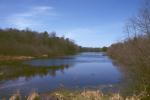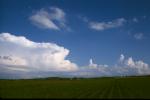Wisconsin Climate Impacts
Climate impacts various sectors of Wisconsin's
ecosystems, economy and society. These impacts are reflected in the statistics of climate variables, in particularly their extreme values, which are illustrated in this section..
Introduction:
How Climate Affects Our World and Our State
Climate impacts our life on earth. Normal
seasonal variations leave changing imprints upon vegetation,
animals, and humans. Applied climatology is the science of
understanding how climate, particularly temperature and
precipitation, affects agriculture, water resources, ecosystems,
energy supply, and the health of humans and animals. The
probable irreversible climate change during the course of this
new century implies permanent changes in impacts as well.
Estimating these changes is an important new challenge for
applied climatology.
Extremes & Impacts
We study these impacts by first analyzing the complete record of
climate and its fluctuations lasting from decades down to days.
These fluctuations are combinations of both complex climate
systems and chaotic weather; they are best described by
probability distributions. Climate impacts on the environment
commonly involve extreme events (e.g. unusually cold conditions
where the
temperature is at the extreme low end of a temperature
probability distribution).
Impact events are often found at
threshold values, such as 32 degrees F, a threshold state that
may have a damaging impact (e.g. freezing).
Such events occur when a combination of normal climate, a
variable climate situation (e.g. El Niño), and a particular
weather pattern (e.g. cold surge) "add up" to a temporary
extreme state (e.g. record sub-freezing temperature).
Changing Impacts
In a changing climate, the probabilities of extreme events will
shift because of:
(a) a trend in "normal climate" (e.g. "climate warming"), (b) a
trend in climate variability (e.g. El Niño years), or (c) change
in weather types (e.g. cold surges diminishing). Climate change
science aims at understanding and predicting changes in the
probabilities of both "changing normals" and extreme events.
Research on changing climate impacts (e.g. WICCI) will follow
these steps:
(1) attribution of past climate/probability changes;
(2) assessment of predicted climate/probability changes;
(3) risk assessment of environmental vulnerabilities to changing extremes;
(4) policy guidance for adaptation in order to minimize future negative impacts.
Collaborations with
Wisconsin Initiative on Climate
Change Impacts (WICCI)
research on climate impacts are now underway.
NOAA Climate Attribution from Earth System Research Laboratory
Understanding & Building Resilience to Climate Risk
The U.S. Climate Resilience Toolkit is designed for state and local decision makers to bolster capacity for resilience to climate-related hazards. Scientific tools, information, and expertise are provided to help people manage their climate-related risks and opportunities, and improve their resilience to extreme events. Check the Toolkit.
Case Studies- For regions pertinent to Wisconsin:
Midwest
Great Lakes
Available Tools:
Tools are available to help manage climate-related risks and opportunities.
An example is AgroClimate.
|

